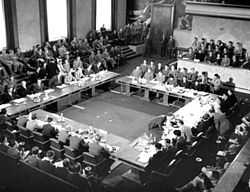Geneva Agreements

The Geneva Agreements of 1954 (also, "Geneva Accords") arranged a settlement which brought about an end to the First Indochina War. The agreement was reached at the end of the Geneva Conference. A ceasefire was signed and France agreed to withdraw its troops from the region. French Indochina was split into three countries: Laos, Cambodia, and Vietnam. Vietnam was to be temporarily divided along the 17th Parallel until elections could be held to unite the country. These elections were never held; following repeated refusals to hold nationwide elections by Ngo Dinh Diem and his declaration of leadership of a new state, South Vietnam, the Vietminh established a communist state in the North led by Ho Chi Minh. The US gave Diem considerable support in the form of financial aid; due to the corruption evident in his regime, and the question of the depth of support for him in Vietnam, there was a certain amount of reluctance in doing so.[2]
Walter Bedell Smith, US representative at the Conference, read a statement on July 21, 1954, in which the US' willingness to abide by the terms of the agreements was implied, and it promised to "refrain from the threat or use of force to disturb" them.[1] Specifically, the statement seemed to promise not only US acquiescence to the mandated elections, but aid in executing them.
In the case of nations now divided against their will, we shall continue to seek to achieve unity through free elections[1]
Black propaganda operations by the CIA commenced within ten days of Smith's announcement; the leaflets dropped on Hanoi were so convincing, that Vietminh denouncements of them were believed by even the Communist party faithful to be French trickery. Registration by Vietnamese wanting to go south to French territory increased threefold, and Vietminh currency halved in value, within days of the leaflet drop.[3]
Aspects of the Conference that have been the subject of controversy include whether it constituted a partition of Viet Nam, the transfer of responsibility for abiding by the agreement from the French representative for Viet Nam, Bảo Đại, to his largely self-appointed (and US-backed) successor Ngo Dinh Diem, and similarly, the extent of US responsibility for abiding by an agreement it did not sign.[2][3][4]
| Wikisource has original text related to this article: |
| Wikisource has original text related to this article: |
Sources for the full text
- East Tennessee State University website: Full text of the Agreements[5]
- Full text of the Geneva Agreement and Final Declaration, The United States in Vietnam: An analysis in depth of the history of America's involvement in Vietnam, Appendix 2.[2]
- Full text of the Agreements Mt. Holyoke College Professor of International Politics website: obtained from source: U.S. Congress, Senate, Committee on Foreign Relations, 90th Congress, 1st Session, Background Information Relating to Southeast Asia and Vietnam (3d Revised Edition) (Washington, D.C.: U.S. Government Printing Office, July 1967), pp. 50–62[4]
- Full text of the Agreement and Final Declaration: Vietnam documents: American and Vietnamese views of the war, by George N. Katsiaficas[6]
- Modern History Sourcebook, Final Declaration
- George N. Katsiaficas. Vietnam documents: American and Vietnamese views of the war. M.E. Sharpe. ISBN 978-0-87332-897-5.
- McGraw Hill full text of the Final Declaration
Citations
- ↑ 1.0 1.1 1.2 George N. Katsiaficas. Vietnam documents: American and Vietnamese views of the war. M.E. Sharpe. ISBN 978-0-87332-897-5.
- ↑ 2.0 2.1 2.2 The United States in Vietnam: An analysis in depth of the history of America's involvement in Vietnam by George McTurnan Kahin and John W. Lewis, Delta Books, 1967
- ↑ 3.0 3.1 George N. Katsiaficas. Vietnam documents. M.E. Sharpe. ISBN 978-0-87332-897-5.Chapter: Report of US Central Intelligence Agency Covert Operations Team in Vietnam 1955. Original: the Pentagon Papers
- ↑ 4.0 4.1 Major Provisions of the 1954 Geneva Accords from The Pentagon Papers, Gravel Edition, Vol 1 Chapter 5
- ↑ Agreement on the Cessation of Hostilities in Viet-Nam, July 20, 1954 Between the French and the Viet Minh East Tennessee State University Department of History
- ↑ George N. Katsiaficas. Vietnam documents: American and Vietnamese views of the war. M.E. Sharpe. ISBN 978-0-87332-897-5.